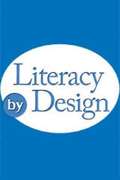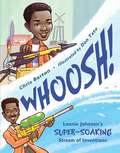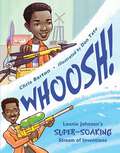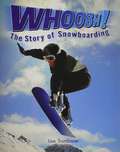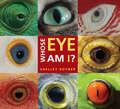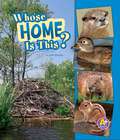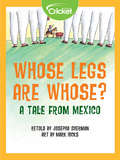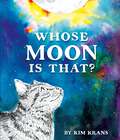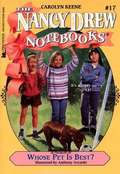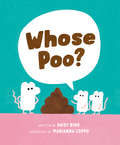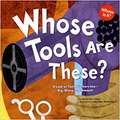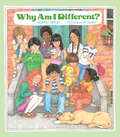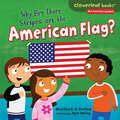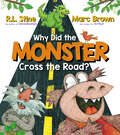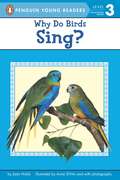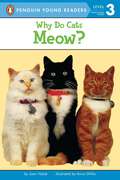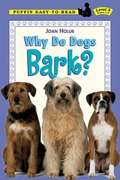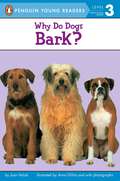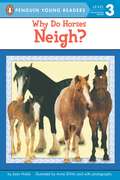- Table View
- List View
Whoosh!: Lonnie Johnson's Super-Soaking Stream Of Inventions (Into Reading, Read Aloud Module 5 #3)
by Chris Barton Don TateNIMAC-sourced textbook <p><p> You know the Super Soaker. It’s one of top twenty toys of all time. And it was invented entirely by accident. Trying to create a new cooling system for refrigerators and air conditioners, impressive inventor Lonnie Johnson instead created the mechanics for the iconic toy. <p> A love for rockets, robots, inventions, and a mind for creativity began early in Lonnie Johnson’s life. Growing up in a house full of brothers and sisters, persistence and a passion for problem solving became the cornerstone for a career as an engineer and his work with NASA. But it is his invention of the Super Soaker water gun that has made his most memorable splash with kids and adults.
Whoosh!: Lonnie Johnson's Super-Soaking Stream of Inventions
by Chris BartonA cool idea with a big splash You know the Super Soaker. It&’s one of top twenty toys of all time. And it was invented entirely by accident. Trying to create a new cooling system for rockets, impressive inventor Lonnie Johnson instead created the mechanics for the iconic toy. A love for rockets, robots, inventions, and a mind for creativity began early in Lonnie Johnson&’s life. Growing up in a house full of brothers and sisters, persistence and a passion for problem solving became the cornerstone for a career as an engineer and his work with NASA. But it is his invention of the Super Soaker water gun that has made his most memorable splash with kids and adults.
Whoosh: The Story of Snowboarding (Into Reading, Level N #72)
by Lisa TrumbauerNIMAC-sourced textbook <p><p> Does sliding downhill on the snow at high speed sound like fun to you? If so, you’d like snowboarding!
Whose Egg Is That? (Whose Is THAT?)
by Darrin LundeA nonfiction guessing game that explores the connections between an animal, its eggs, and its habitat.Written by a mammalogist at the Smithsonian, this clever preschool page-turner pairs seven eggs with information about the animals' survival mechanisms, asking kids to guess which animal laid which egg. Whose Egg Is That? reveals the animals--ranging from penguins to platypuses--in their own habitats.
Whose Eye Am I?
by Shelley Rotner"Who am I?" ask captions alongside close-ups of colorful animal eyes. As readers guess which animal belongs to each eye, they will discover that each animal has a unique and amazing way of seeing. Snakes have clear eyelids that cannot ever open or close. Some sea creatures have hundreds of eyes around the edges of their shells. Many animals can see colors that are invisible to humans. Brimming with vivid and engaging photographs, this book also includes a clear explanation of how human eyes work, a labeled diagram of a human eye, a glossary, and an index.
Whose Footprint Is That? (Whose Is THAT?)
by Darrin LundeA nonfiction guessing game that explores the connections between an animal, its tracks, and its habitat.Written by a mammalogist at the Smithsonian, this clever preschool page-turner pairs seven tracks with information about the animals' locomotion, asking kids to guess which animal left which tracks behind. Whose Footprint Is That? reveals the animals--ranging from flamingos to kangaroos--in their own habitats.
Whose Home Is This? (Nature Starts Ser.)
by Julie MurphyAnimals live in many kinds of homes. Some live under the sea. Others live high in the trees. Can you match each animal to its home? Fun clues and multiple choice photos will you have puzzling to learn more!
Whose Legs Are Whose? A Tale from Mexico
by Josepha ShermanThe people of the town of Lagos de Moreno weren't really fools—not exactly. They simply saw things differently from everyone else!
Whose Moon Is That?
by Kim KransA stunning picture book that addresses the question: do any of us "own" nature? When a curious cat asks the question, "Whose moon is that?", a panoply of animals try to stake their claim. The wolf, the owl, and the starry sky all have their reasons, but the moon ultimately answers for herself -- her light is meant to be shared by everyone. Kim Krans's stunning ink-and-watercolor illustrations beautifully illuminate this simple exploration of our relationship to the world around us and our place in it.
Whose Pet Is Best? (The Nancy Drew Notebooks #17)
by Carolyn KeeneWHAT'S ON TV? IS IT NANCY DREW? It's the Amazing Pet Contest, and the winner gets to go on Mr. Lizard's Funhouse . . . on TV! Katie's got a singing parrot. David's got a gross rat. And Nancy's got Chocolate Chip, her soccer-playing puppy. . . . But Chip won't do her trick. Something's wrong, and Nancy's afraid she's sick. She also thinks it just wouldn't be fair if Chip doesn't get to go on TV because somebody played a dirty trick on her!
Whose Poo?
by Daisy BirdFor fans of Everyone Poops, a hilariously fresh take on POO! A trip to the zoo turns into a very silly discussion about poo, as two siblings wonder what sort of poo each and every creature would do.One day, Daddy Rat announces to his baby rats that he'll be taking them to the zoo . . . but only if they're good, which means no talking about poo! And yet, before the family can even leave the house, the two rascally siblings can't help but wonder . . . what sort of poo would an astronaut do? Shiny, silver, space-age poo! Rocket-powered, weightless poo, and it spins round and round like a planet does, too! Head chefs, balloon sellers, blue whales . . . everyone and everything must have a unique poo, and the siblings simply have to stop and imagine each and every one (much to the chagrin of Daddy Rat, who is getting increasingly irritated with all the poo talk). Once the rats finally reach the zoo, things escalate, because of course each and every animal in the zoo must do a special kind of poo! Finally, Daddy Rat has simply had enough, and is forced to sit down and explain the facts to his curious kids. And when he thinks he may have gotten through to his youngsters, he encounters a surprising (and smelly) twist which will have little rats everywhere laughing out loud!
Whose Poop Is That? (Whose Is THAT?)
by Darrin LundePoop! Ewwww!No, don&’t say &“Ewwww.&” Ask, &“Whose poop is that?&” This simple, and yes, charming book asks this question about seven examples of animal poop. By investigating visual clues, young readers can learn to identify the animal through its droppings. For instance, find a sample of poop with bits of bone and tufts of hair. Turn the page to learn it came from a fox! Kelsey Oseid&’s illustrations are both accurate and beautiful. Backmatter includes further information about the poop and what scientists can learn from an animal&’s droppings."A primer on poop and a guessing game, especially for those just beyond toilet training" — Kirkus Reviews"Gross-out details will provoke glee...but kids will learn plenty about the variety and importance of animal waste, too" —Publisher's Weekly"As accessible to newly independent readers as it is to younger listeners" — Bulletin of the Center for Children's Books"Sure to appeal to curious youngsters. Recommended for collections that can't get enough titles on poop" — School Library Journal"The kid-friendly illustrations and matter-of-fact tone make this title an informative, rather than a gross-out, pick, though is certainly what will get kids reaching for the shelves" — Booklist"Friendly and inviting to novice naturalists" — Horn Book"What are you waiting for? Come get the &“scoop on poop&”!" — NSTA Recommends
Whose Tools are These: A Look At Tools Workers Use - Big, Sharp, And Smooth (Whose Is It?)
by Sharon Katz CooperThis book introduces the child to number of tools used by people of various professions.
Whose Way Today?
by Carlynn TroutTwo brothers can't agree on what to play when their cousin visits. As you read, try to predict how the story will end after the older brother doesn't get his way. Number of Words: 683
Why Am I Different?
by Dora Leder Norma SimonPortrays everyday situations in which children see themselves as "different" in family life, preferences, and aptitudes, and yet, feel that being different is all right.
Why Are There Stripes on the American Flag? (Cloverleaf Books (tm) -- Our American Symbols Ser.)
by Kyle Poling Martha E. RustadDo you know why the US flag has stars and stripes on it? What does the flag stand for, and why do we say the Pledge of Allegiance? Join Mr. Gomez's class as they study the flag to find out! They'll learn when the first American flag was made, what the Pledge of Allegiance means, and why we still honor the flag today.
Why Coyote Howls at the Moon (Rigby Leveled Library, Level L #38)
by Rob Arego Vicki BradleyNIMAC-sourced textbook
Why Did the Monster Cross the Road?
by R. L. StineFrom beloved, bestselling children's book icons, R.L. Stine and Marc Brown, comes a storybook filled with hilariously spooky jokes and fun-loving monsters that will have everyone giggling!Why did the monster cross the road?To BITE someone on the other side!Turn scary to silly with this laugh-out-loud joke book. Hunny and Funny are monster best friends. When Hunny is feeling sad, Funny knows exactly how to cheer up his friend… with laughter!Renowned bestselling children's book talents R.L. Stine, creator of the Goosebumps series, and Marc Brown, creator of the Arthur Adventure series, join forces once again in this sweet, fun-filled story that not only teaches readers hilarious jokes to share but also reminds children that laughter is the best medicine when you're feeling down. With Stine's humorous text and Brown's bold artwork, this monster-themed picture book is sure to get the monsters and furry creatures giggling all night!
Why Do Birds Sing? (Penguin Young Readers, Level 3)
by Joan HolubDo you love birds? If you do, you're not alone! Birds are fun to watch and they make great pets. There is so much to know about birds. Why do they have feathers? Can parrots really talk? Why do birds build nests? Do birds like toys? Beginning readers will find the answers to these questions—and many more—in this lively, fact-filled book. Filled with colorful illustrations and photographs of wild and domestic birds, this is a perfect selection for any young bird-watcher or bird lover.
Why Do Cats Meow? (Penguin Young Readers, Level 3)
by Joan HolubMany children love cats, and there is so much to know about America's most popular pet. Why do they meow, hiss, and purr? Why do they have whiskers, tails, and claws? Beginning readers can find out the answers to those questions and many more in this fun, fact-packed book filled with colorful feline photos and drawings.
Why Do Dogs Bark?
by Joan HolubDid you know that there's a dog so little, it can fit in your hand? That dogs and wolves are relatives? A dog once kept a snowbound town from getting sick? That dogs, unfortunately, cannot brush their teeth? Dogs are our friends, protectors, and family members. This fact-packed book takes a look at their history, behavior, and characteristics, and offers ways to get to know them a little better. For instance, what does it mean if a dog's tail is up, or its ears are back? How can you get a dog to sit or stay? And, of course, just what is the reason for all that barking?
Why Do Dogs Bark? (Penguin Young Readers, Level 3)
by Joan HolubThere are many different kinds of dogs and so much to find out about them. Why do dogs bark, howl, or bury bones? Why do they like to lick and sniff people? What jobs can dogs do? You'll find the answers to these questions and many more in this fact-filled reader about man's best friend.
Why Do Horses Neigh? (Penguin Young Readers, Level 3)
by Joan HolubDo you love horses? If you do, you're not alone. There's so much to know about these amazing animals. Why do horses neigh? What are baby and adult horses called? How do horses communicate? Beginning readers can find out the answers to these questions-and many more-in this lively, fact-filled introduction to these popular animals. Filled with colorful illustrations and dynamic color photos of real horses, this is a perfect selection for any young horse lover.Illustrated by Anna DiVito.
